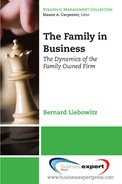Anderson, R. C., & Reeb, D. M. (2003). Founding-family ownership and firm performance: Evidence from the S&P 500. Journal of Finance, 53(3), 1301–1328.
Barach, J. A. (1984, Fall). Is there a cure for the paralyzed family board? Sloan Management Review, 3–12.
Caplow, T. (1968). Two against one: Coalitions in triads. Englewood Cliffs, NJ: Prentice Hall.
Chrisman, J. J., Chua, J. H., & Sharma, P. (2005, September). Trends and directions in the development of a strategic management theory of the family firm. Entrepreneurship Theory and Practice, 555–575.
Chua, J. H., Chrisman, J. J., & Bergiel, E. B. (2009, March). An agency theoretic analysis of the professionalized family firm. Entrepreneurship Theory and Practice, 355–372.
Dalton, M. A., & Hollenbeck, G. P. (1996). How to design an effective system for developing managers and executives. Greensboro, NC: Center for Creative Leadership.
Danco, L. A. (1978). Beyond survival. Cleveland, OH: University Press.
Denison, D., Lief, C., & Ward, J. (2004). Culture in family-owned enterprises: Recognizing and leveraging unique strengths. Family Business Review 17(1), 61–70.
Galbraith, J. R. (1995). Designing organizations: An executive briefing on strategy, structure, and process. San Francisco, CA: Jossey-Bass.
Hisrich, R., Langan-Fox, J., & Grant, S. (2007, Summer). Entrepreneurship research and practice: A call to action for psychology. American Psychologist, 575–589.
Klein, S. B., Astrachan, J. H., & Smymios, K. X. (2005, May). The F-PEC scale of family influence: Construction, validation and further implication for theory. Entrepreneurship Theory and Practice, 321–339.
Kwak, M. (2003, Winter). The advantages of family ownership. MIT Sloan Management Review, 12.
Levinson, H. (1971, March–April). Conflicts that plague family businesses. Harvard Business Review, 90–98.
Liebowitz, B. (2010). Succeeding at the top: A self-paced workbook for newly appointed CEOs and executives. New York, NY: Business Expert Press.
Mattera, P. (2010, Fall). The dark side of family business. Social Policy, 48.
Miller, D., Steier, L., & Le Breton-Miller, I. (2003). Lost in time: Intergenerational succession, change and failure in family business. Journal of Business Venturing, 18, 513–531.
Shepherd, D., & Haynie, J. M. (2009, November). Family business, identity conflict, and an expedited entrepreneurial process: A process of resolving identity conflict. Entrepreneurship Theory and Practice, 1245–1264.
Trevinyo-Rodriguez, R. N. (2010). Effective knowledge transfer in family firms. Working Paper WP-865, IESE Business School, University of Navarra, July, 1–18.
Tsai, S. P., Wendt, J. K., Donnelly, R. P., de Jong, G., and Ahmed, F. S. (2005). Age at retirement and long term survival of an industrial population: Prospective cohort study. British Medical Journal, doi:10.1136/bmj.38586.448704.E0 (published 21 October).
Ward, J. (1987). Keeping the family business healthy. San Francisco, CA: Jossey-Bass.
White, W. S., Krinke, T. D., & Geller, D. L. (2004, May). Family business succession planning: Devising and overall strategy. Journal of Financial Service Professionals, 67–96.
Zahra, S. A., Hayton, J. C., Neubaum, D. O., Dibrell, C., & Craig, J. (2008, November). Culture of family commitment and strategic flexibility: The moderating effect of stewardship. Entrepreneurship Theory and Practice, 1035–1054.
